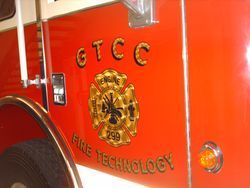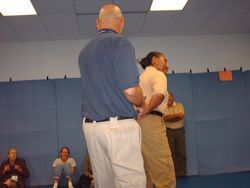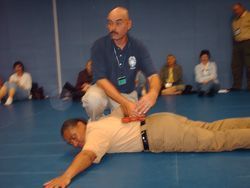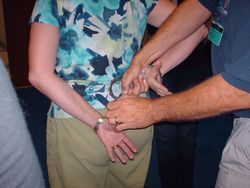My Awesome Experience at the Writer's Police Academy
From the time we arrived at WPA in Greensboro, NC on Thursday afternoon, until we left, Sunday noontime, it was a non-stop whirlwind of information.
I started with a tour of the Guilford County Detention Center (Jailhouse) in High Point, NC which was built in 1990 to house 274 inmates, but as of last year actually housed 423 inmates. They are currently awaiting the completion of a new facility. 85% of the inmates are pre-trial, the remaining inmates are serving short sentences. We learned some interesting statistics about the population and the guards, such as the amount of suicide attempts, some successful, some not, and the ratio of men to women, thier crimes and the recitivism rates. We learned about how the guards deal with working with criminals on a daily basis and their philosophy of treating all inmates with the same respect and forgetting why they may be in there and concentrating strictly on their behavior while they are inside. We learned how they handle unruly inmates, what types of protective gear they carried, and found that often one woman officer can control a floor of male inmates better than several men on the floor. (One more inclined to use brains than brawn.)There was much more, but you would have to take a tour to learn it all.
We were up at 5:30am so we could eat breakfast and be on the bus by 7:30am heading for the Guilford County Community Technical College (Law Enforcement & Firefighter Academy.)
There were writers from as far away as Ontario and Alaska, and the wonderful instructors came from as far away as Portland Oregon. It was indeed an honor to meet some of the best law enforcement people in the country.
Our day started with a tour of the Firefighters Training facility, their fire trucks and equipment. We learned how they train to put out all types of fires, like gas tank explosions, etc. We toured a burned building and learned first hand how difficult it is to see inside, as it's pitch black and the burned smell is very strong. If there were an actual fire the smoke would make it impossible to see, and the firefighters would easily become disoriented. We had to maneuver around charred stuff?, find a stairwell and go down and out to exit the building...scary.
One of my favorite classes was the: Viewing the Crime Scene in a Different Light. Among many other things, I learned why, when you are watching CSI programs and wondering why they are always walking around trying to find things in the dark, that they won't turn on the lights. The instructor, David Pauly teaches Applied Forensic Science at Methodist University and the Basic Crime Scene Photography Course at Sirchie industry facilities in Youngsville, NC, the largest supplier to the world in forensic investigative equipment. He showed us all the latest technological lighting equipment to see things like blood spatter, semen, etc.
Another of my favorites was learning how to fend of an abductor in the Women's Personal Safety and Self-Protection class. "Bad guys watch out -- mess with me and you might lose your hearing -- or worse" The Handcuffing and Arrest Techniques gave us valuable information so we could write the scenes properly, possibly humorously.
My roommate, Bev Pinske liked the Bioterrorism class the best. I liked it too, but my favorite, was The Role of Digital Evidence and solving crimes in cyberspace. Josh Moulin, Lieutenant Task Force Commander of the High-Tech Crimes Task Force located in Southern Oregon has a 100% conviction rate when it comes to solving cyber crimes. This task force of 10 is amazing! Anything a writer might wish to know about "hacking" and "cybercrimes" can be found through this website. It's a great resource.
My next, Yvonne Suarez mystery is a cold case, so I was glad to learn from Dave Pauly and Katherine Ramsland (Forensic Psychologist), why cases go cold and what determines whether they will be investigated, when and if new information comes to light.
We learned about Women in Law Enforcement, the role and actions of undercover agents and about DNA testing (what's realistic, and what strives have been made), and how to read the DNA strands. So much to remember and perhaps use in a future mystery.
We had lots of fun listening to the funny stories illustrating what not to do in police procedures and forensic investigations. And, we shared our time with many fun and creative writers. Many from Sisters in Crime, some veteran and popular writers in attendance had written 30 or more novels, so we first timers felt priviliged to be in their company.
What a great time, and a valuable one too. I highly recommend it. I hear that the Keynote Speaker for next year will be Lee Child....Woo Hoo!
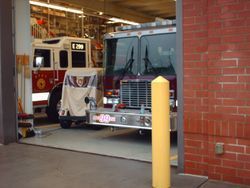
A glance into the fire house at the fire trucks
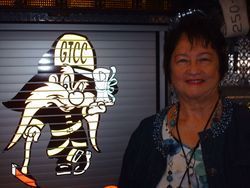
Bev Pinske stands next to Yosemite Sam on the back of the fire engine.
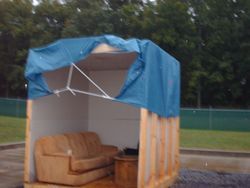
Furniture to Burn. Not shown are the cars to burn.
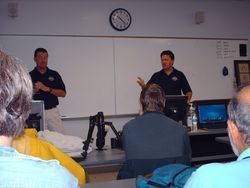
Viewing the Crime Scene in A Different Light
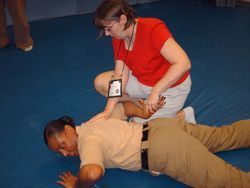
Writer practices arresting and subduing
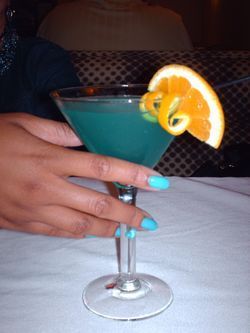
Friday night at Embassy Suites, waitress delivers a Blue Martini and has matching nail polish. I just had to take a picture.
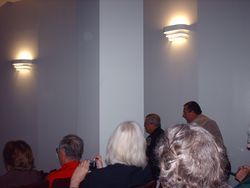
Watching police handle a hostage situation.
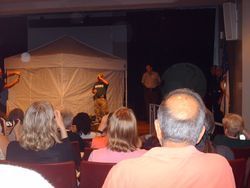
Sniper on stage after shooting the hostage taker.
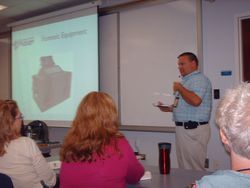
One of the latest Digital Investigation Devices.

